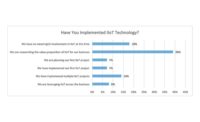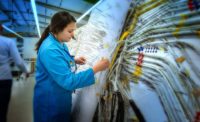The Industrial Internet of Things (IIoT) is more than just the latest manufacturing fad. It promises to transform the way that many types of products are designed, assembled and serviced.
The goal is to deploy a network of “smart” machines and systems, including wire processing equipment, that contain embedded technology, such as sensors and software, to communicate and share intelligence with each other. The adoption of IIoT technology will also enable wire processing devices to communicate with engineers, operators and plant managers.
That type of interconnectivity will provide an unprecedented amount of information that improves data collection and traceability. It will also enable predictive analysis and process optimization.
Wire processing equipment doesn’t have to be new, sophisticated or expensive to connect to a data collection system. With the emergence of the IIoT, it’s now easier than ever to measure the productivity of any machine on the plant floor, and easy to connect operators, engineers and management with real-time results.
“Streamlined processes, short turnaround times, low inventory levels, increased competition and cost pressures are challenging many manufacturers today,” says Bernd Jost, managing director of DiIT AG, a leading provider of manufacturing execution system (MES) software. “Engineers should collect and evaluate machine data to produce better products. You can now track down inefficiencies and display them in numerical values.”
Jost believes that most manufacturing engineers still lack the tools needed to derive useful insights from all the collected data. “IIoT analysis functions are a new category,” he points out. “This includes filtering data and streaming analysis to monitor data in real time, as well as advanced analysis to extract hidden patterns and insights from the collected information.”
Software tools can help both large and small wire harness shops improve quality and increase efficiency.
“The IIoT is fantastic for wire processing applications,” says Rob Boyd, senior product manager at Schleuniger Inc. “It used to be that a machine was a machine. Getting any data out of it was something that you had to do manually.
“But, things are changing a lot in terms of machine capabilities,” explains Boyd. “For instance, our simple benchtop end-stripping units now have bar code capability. A few years ago, that wasn’t even an option.
“Today, machines are becoming quasi measurement devices,” notes Boyd. “This allows engineers to extract all types of data from the equipment in real time.
“MES software ties all the machines together, including large, stand-alone fully automated cut-and-strip machines and small, semiautomated benchtop crimping units,” Boyd points out. “Interfaces enable quality verifications on materials before operators are allowed to run a job.
“It also allows you to become much more efficient with your existing equipment,” says Boyd. “MES software shows you what the production challenges are and where the bottlenecks are so you can address them and make the overall system more efficient.”
According to Boyd, the IIoT trend is being driven by large manufacturers, such as automakers and Tier 1 suppliers. “The more machines you have, there’s more room for wire processing errors and inefficiencies,” he explains. “MES software has made a huge difference in terms of improving work in process, error-proofing and on-time deliveries.
“There are many small- and medium-sized companies that can also benefit from the efficiencies that can be gained from IIoT technology,” says Boyd. “However, unless you already have some kind of an active system to accurately track things like machine uptime, actual set up time and machine utilization, you’re really just estimating or taking a guess.
“Implementing an MES system can be a big step for small manufacturers or wire harness shops,” warns Boyd. “There is some risk and expense to it, but the benefits are worth it.”
Product Traceability
Boyd and other experts claim that the IIoT will play a key role in future wire processing applications. One of the biggest benefits will be better traceability.
“The comprehensive, integrated networking and digitization of wire harness production, from engineering drawings to shop floor machines, is a prerequisite for optimizing production processes,” says Jost. “With just-in-time and just-in-sequence assembly, this will be increasingly indispensable for every manufacturer, especially in the auto industry.”
For example, IIoT technology makes it possible to uniquely identify each part and component, such as connectors, and assign them to the respective wire processing step. The more complex processes become, it becomes easier to ensure the necessary quality standards.
“The advantage of using IIoT for stripping, cutting, crimping and other wire processing applications is traceability, quality assurance, process optimization and avoiding errors,” claims Jost.
“To ensure quality, manufacturers today must know each and every component used, which means that they not only need to know who produced it and when, but which batches of intermediate products or raw materials were used, which machines and systems were used, and which employees were involved,” notes Jost. “In other words, manufacturers have to guarantee continuous traceability for each part or component used in a wire harness.
“Traceability enables faults to be isolated so that manufacturers don’t have to recall complete series, but can restrict the recall to those products in which the faulty parts were incorporated or were produced with a specific machine,” explains Jost. “To set up traceability, the MES assigns a unique ID to each wire bundle and manages it continuously throughout its history.
“It can accurately document on which day, on which machine, by which employee and with which tools the individual components were produced,” says Jost. “This enables any future repairs or recalls to be targeted accurately.”
The IIoT can connect all wire processing devices together. And, there’s no reason that an older piece of equipment can’t be easily and cost effectively connected.
“In my opinion, there is no sector that has more to gain from this new technology than wire harness manufacturers,” says Paul Hogendoorn, president of FreePoint Technologies Inc., an MES software supplier. “Most companies produce products at pennies-per-part prices. The tolerance for defects is effectively zero, and the requirement for accountability and traceability is increasing.
“Tier 1 suppliers have to keep track of the raw materials and components that go into each harness, the equipment it was run on, the tooling that was used, and even when that tooling was last serviced or refurbished,” adds Hogendoorn, who delivered a presentation on the topic at the 2017 Electrical Wire Processing Technology Expo in Milwaukee.
“In-process and end-of-process test results often have to be associated not just with the batch, but with the specific product produced,” adds Hogendoorn. “IIoT technologies do not, by themselves, solve all these problems. But, the IIoT provides wire harness shops with simple, ubiquitous, cost-effective ways to connect all devices.
“The rapid emergence of this new technology is our industry’s chance to build ‘data bridges,’ not data fences and silos,” claims Hogendoorn.
Some industries, such as the automotive sector, are plagued with product recalls. Many of them are due to electrical problems caused by faulty wiring harnesses.
“The more complex production processes become, the more complicated and difficult it is to ensure the necessary quality standards,” says Jost. “It is not only a question of retaining a continuous overview of tens of thousands of parts and components, but also remembering that these parts originate from an almost incalculable number of suppliers who themselves use the complex tiered structures of their own upstream suppliers.”
Due to the huge volume of data involved, Jost says traceability can only be addressed by using a software system that addresses three issues:
Quality assurance. “Traceability enables the specific detection of a fault so it can be determined exactly which batch on which machine is responsible for a fault, which also means that targeted counter measures can be implemented promptly,” explains Jost.
Product liability. “Traceability also makes it possible to trace the defective parts to their respective suppliers, thereby making it possible to prevent any ensuing damages or claims within the scope of product liability,” says Jost.
Recalls. “Traceability enables faults to be isolated so that automakers do not have to recall complete series, but can restrict the recall to those vehicles in which the faulty parts were incorporated or which were produced with a specific machine,” adds Jost. “This aspect is important, because this can affect whether 200 or 200,000 vehicles have to be recalled.”
Powerful Tools
An MES collects detailed data on plant-floor activities, typically operating between an enterprise resource planning (ERP) system and manufacturing equipment. It captures all real-time production activity and tracks inventory for traceability.
The advent of IIoT technology has revolutionized the amount and type of data that’s available to engineers. It enables them to extract and analyze vast quantities of information to optimize the performance of assembly lines.
“Traditional MES are now reaching their limits in situations where manufacturing processes are so specific they can no longer be reasonably mapped in a more general, more abstract process model,” says Jost.
“In wire harness production, there are still many manual assembly steps,” adds Jost. “While wire cutting is a highly automated process, the rest of production is highly manual.”
For instance, during the vehicle design and development process, automakers provide a design of the wire harness to a supplier to create a production drawing, a work plan and corresponding parts lists, which are frequently changed on short notice.
“This activity is still mainly carried out manually by relatively large teams,” claims Jost. “It is therefore prone to errors and also suffers from time constraints.
“With the increased embedding of systems in digital processes and structures, MES has now become a key component of wire harness production,” Jost points out. “Positioned between ERP systems and control systems at machine level, they organize the entire process and ensure the optimum distribution of resources. Even when these very complex processes are performed manually, they can also be supported by an MES.”
DiIT produces a popular software suite called 4Wire. It’s used by Tier 1 suppliers such as Leoni, Sumitomo and Yazaki.
“An MES adapted to specific conditions is indispensable for the production of wire harnesses,” says Jost. “It not only ensures efficient production; it enables software-controlled quality control.”
According to Jost, many suppliers of wire harnesses can only roughly estimate how the use of an MES impacts key figures in their production process. That’s why DiIT recently launched a payback calculator that enables engineers to evaluate a wide range of scenarios.
“This Web tool can quickly determine the point at which it is worth investing in MES software for cutting machines,” says Jost. “Small- and medium-sized suppliers of wire harnesses are usually unsure whether an investment in a comprehensive control system is really worthwhile for them. With the payback calculator, they can now determine this for themselves using their own data, ensuring that their decisions are based on reliable data and not on assumptions.”
The 4Wire CAO (cutting and assembly optimization) Payback Calculator captures important data, such as the number of machines used, employees per machine, and costs per employee and machine. Target parameters considered include machine capacity utilization, quality rates and lead time in days. The dashboard graphically displays how any change in the parameters will impact output and earnings.






